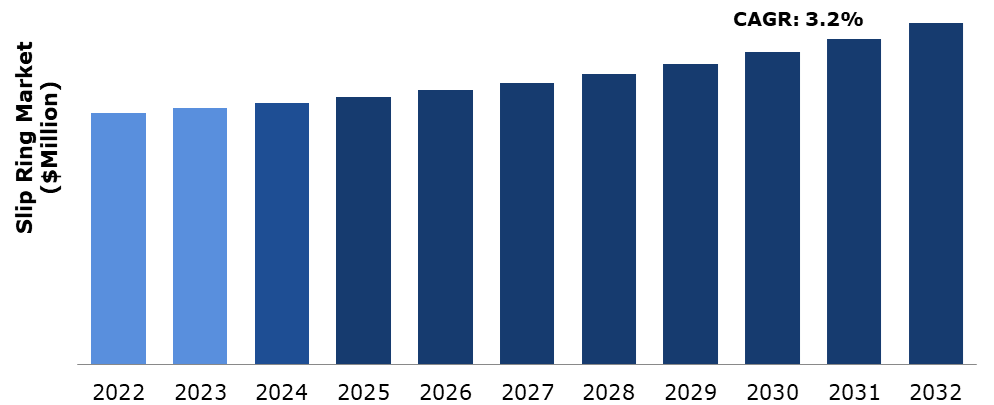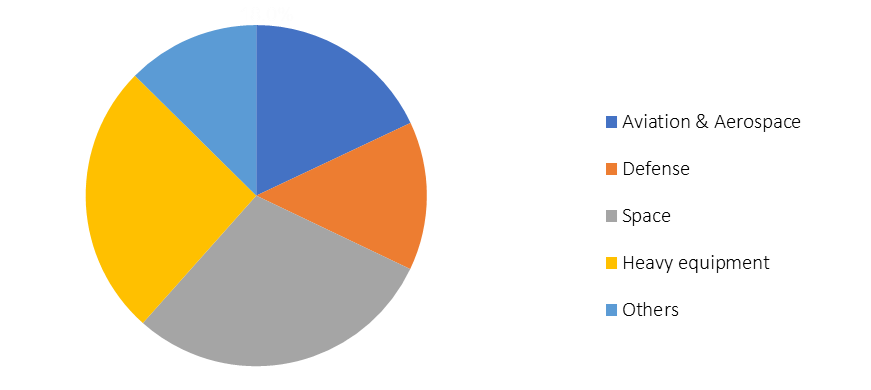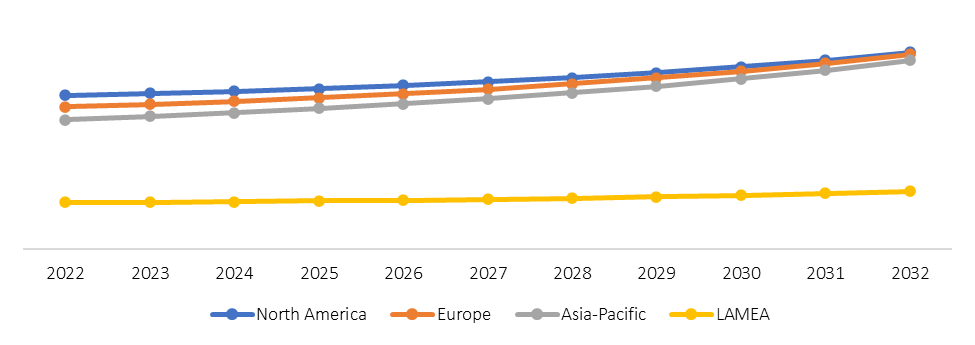Global Slip Ring Market Report
RA08761
Global Slip Ring Market by Product Type (Mercury-wetted Slip Rings, Pancake Slip Rings, Wireless Slip Rings, and Others), End User (Aviation & Aerospace, Defense, Space, Heavy Equipment, and Others), and Region (North America, Europe, Asia-Pacific, and LAMEA): Opportunity Analysis and Industry Forecast, 2023-2032
Slip Ring Overview
A slip ring, also known as a rotary electrical joint, is a device used to transfer electrical signals and power between a stationary structure and a rotating structure. It allows the transmission of electrical current, data signals, or other media from a stationary platform to a rotating component or vice versa. Slip rings consist of two main parts: a stationary component, often referred to as the stator, and a rotating component, known as the rotor. The stator is typically mounted on the stationary part of the system, while the rotor is attached to the rotating part. The two components are separated by a small gap, allowing the rotor to rotate freely while maintaining electrical connectivity.
Inside the slip ring, there are conductive materials, such as metal brushes or brushes made of carbon/graphite, that make continuous contact with conducting rings or tracks on the rotor. These rings or tracks are connected to the electrical circuit, allowing the transfer of signals or power through the brushes. Slip rings are commonly used in various applications that involve rotational motion, such as electric motors, generators, wind turbines, radar systems, robotics, and rotary sensors. They enable the transmission of electrical power, control signals, ethernet data, video signals, and other types of communication across the rotating interface, eliminating the need for cables that can be twisted or tangled with continuous rotation.
Global Slip Ring Market Analysis
The global slip ring market size was $1,250.00 million in 2022 and is predicted to grow with a CAGR of 3.2%, by generating a revenue of $1,693.10 million by 2032.
Source: Research Dive Analysis
COVID-19 Impact on Global Slip Ring Market
The COVID-19 pandemic had a significant impact on the slip ring market. The global supply chain was disrupted due to lockdowns and travel restrictions imposed by various countries to control the spread of the virus. This led to delays in the production and delivery of slip rings, affecting the market growth. Many industries, such as automotive, aerospace, and manufacturing, experienced a decline in demand for slip rings as their operations were halted or scaled back during the pandemic. The pandemic caused an economic slowdown globally, leading to reduced investments in infrastructure projects and industrial activities. As slip rings are commonly used in these sectors, the market has been affected by the decline in new projects and investments. With social distancing measures in place, there has been a shift towards online platforms for business transactions. While this has allowed some slip ring manufacturers to continue their operations, it has also led to increased competition and price sensitivity among buyers.
Governments and industries primarily focused on essential sectors, such as healthcare and telecommunications, during the pandemic. Therefore, the demand for slip rings in these sectors remained relatively stable, while other sectors experienced a decline. The demand for slip rings is likely to rebound with the resumption of projects and increased investments in sectors like renewable energy, robotics, and automation in the post-pandemic period.
Growing Demand for Automation to Drive the Market Growth
The rise in industrial automation across various sectors, such as manufacturing, packaging, robotics, and automotive requires seamless communication between stationary and rotating components. Slip rings enable the transmission of power, control signals, and data, allowing automated machinery to operate efficiently and reliably. Moreover, robotics is a rapidly growing field, and slip rings are integral to the functioning of robotic systems. Robots often have rotating joints and require a continuous power supply and signal transfer for motor control, sensors, cameras, and other peripherals. Slip rings provide a reliable solution for these requirements. Furthermore, automated packaging machineries, such as rotary fillers, labelers, and capping machines, rely on slip rings to transfer power and signals to rotating parts. This enables precise control over the packaging process and ensures smooth and uninterrupted operation. In addition, many manufacturing processes involve rotating equipment, such as CNC machines, printing presses, winding machines, and textile machinery. Slip rings are used in these machines to transmit power and control signals for motors, sensors, feedback systems, and other components. Furthermore, the automotive industry has witnessed significant automation advancements in areas like assembly lines, welding robots, and automated inspection systems. Slip rings are essential for transmitting power and signals to rotating components in automotive manufacturing equipment, contributing to increased efficiency and productivity. The growing focus on renewable energy sources, such as wind turbines and solar tracking systems, has created a demand for slip rings. These systems require the transfer of power and data from the rotating components to stationary parts for efficient operation and monitoring. The increasing automation across industries has amplified the need for slip rings to enable seamless communication and efficient operation between stationary and rotating components in machinery and equipment.
To know more about global slip ring market drivers, get in touch with our analysts here.
High Maintenance and Replacement Costs to Restrain the Market Growth
The high maintenance and replacement costs can be a restraint for the slip ring market expansion. Slip rings are electromechanical devices that experience wear and tear over time due to continuous rotation and electrical contact. This can result in degraded performance and eventual failure, necessitating maintenance or replacement. The costs associated with such maintenance and replacement can indeed be significant, particularly in large industrial applications where slip rings are commonly used. The expenses include not only the cost of the slip ring itself but also the labor and downtime required for installation, testing, and calibration. Moreover, these high costs can deter potential customers from adopting slip-ring solutions and encourage them to explore alternative technologies that may have lower maintenance requirements or longer operational lifetimes. Customers may consider options such as wireless transmission systems, fiber optic rotary joints, or other contactless electrical transmission technologies that eliminate the need for physical contact and thus reduce maintenance and replacement needs. To address this challenge, slip-ring manufacturers and suppliers are continuously working on improving the durability and reliability of their products. They invest in R&D to enhance the materials, design, and manufacturing processes of slip rings, aiming to extend their operational lifespan and reduce maintenance requirements, which is anticipated to hamper the slip ring market growth in the upcoming years.
Technological Advancements to Drive Excellent Opportunities
The demand for compact and high-speed slip rings is increasing across various industries. Advancements in slip ring technology allow manufacturers to develop smaller, more efficient, and high-speed slip rings. These compact designs enable their integration into space-constrained applications where size and weight are critical, such as in robotics, medical devices, and aerospace systems. Moreover, as technology evolves, there is a growing need for slip rings with enhanced performance capabilities. Manufacturers investing in R&D can improve slip ring designs, materials, and performance parameters such as electrical conductivity, signal quality, low friction, and reduced noise. By offering high-performance slip rings, companies can meet the demands of emerging applications like wind turbines, electric vehicles, and automation systems. Furthermore, technological advancements allow manufacturers to provide customized and tailored slip ring solutions based on specific customer needs. This customization can include factors such as the number of circuits, signal types, operating speeds, environmental considerations, and integration with other components. By offering tailored solutions, manufacturers can cater to a wide range of industries and applications, expanding their customer base. Ongoing technological advancements in slip-ring technology create opportunities to tap into new market segments. Industries such as renewable energy, electric vehicles, industrial automation, and medical devices are experiencing significant growth. The integration of slip rings with the Internet of Things (IoT) and Industry 4.0 technologies presents another avenue for market growth.
To know more about global slip ring market opportunities, get in touch with our analysts here.
Global Slip Ring Market Share, by Product Type, 2022
Source: Research Dive Analysis
The pancake slip rings sub-segment accounted for the highest market share in 2022. Pancake slip rings are preferred in applications where space is limited and traditional cylindrical slip rings may not fit. The demand for smaller and more compact slip rings has increased with the miniaturization of devices and systems. As industries increasingly demand high-speed data transmission and power capabilities, pancake slip rings become crucial due to their ability to handle a large number of circuits and data channels within a confined space. The growing automation and robotics industries require slip rings that can handle complex motion and precise control. Pancake slip rings are well-suited for such applications as they can provide rotation without interfering with the robot's overall design. Moreover, in the medical field, pancake slip rings are used in imaging equipment, endoscopes, and other devices where compact, reliable electrical transmission is essential. As industrial processes and machinery become more automated, the demand for slip rings that can handle high-speed data and power transfer while occupying minimal space is likely to increase. Ongoing advancements in slip ring technology, such as improved materials, contact technologies, and manufacturing processes, are expected to drive the adoption of pancake slip rings in various applications.
Global Slip Ring Market Share, by End User, 2022
Source: Research Dive Analysis
The space sub-segment accounted for the highest market share in 2022. As the trend in the space industry has been towards miniaturization and weight reduction of satellite systems to reduce launch costs, slip ring manufacturers are compelled to develop compact, lightweight, and yet highly efficient slip rings to meet these demands. Moreover, the growing number of satellites being launched into space for communication, earth observation, navigation, and scientific research have created a demand for reliable and high-performance slip rings. These slip rings are crucial components in satellite systems to transfer power and data between the rotating and stationary parts of the spacecraft. Furthermore, ongoing advancements in slip ring technology, including the use of advanced materials, contactless technologies (fiber optic or wireless), and improved sealing techniques, have contributed to their increased adoption in space applications. These advancements help address challenges related to wear, friction, and electrical performance in harsh space environments. The rise of private space companies, such as SpaceX, Blue Origin, and others, has significantly expanded the commercial space sector. These companies require reliable slip rings for their satellite constellations, space tourism initiatives, and other space-based ventures.
Global Slip Ring Market Size & Forecast, by Region, 2022-2032 ($Million)
Source: Research Dive Analysis
The North America slip ring market generated the highest revenue in 2022. North America has a strong presence in industries such as manufacturing, automotive, aerospace, and robotics, which heavily rely on slip rings for the transmission of signals and power in rotating machinery. As industrial automation continues to grow and these industries adopt more sophisticated machinery and robotic systems, the demand for slip rings is likely to increase. Moreover, the renewable energy sector and especially wind power, has been expanding in North America. Wind turbines use slip rings to transfer electricity generated by the rotating blades to the stationary components. As wind energy installations increase, so does the demand for slip rings in this sector. Furthermore, the defense and aerospace industries in North America are prominent users of slip rings for various applications such as radars, turrets, communication systems, and surveillance equipment. As these sectors continue to invest in advanced technology and equipment, the demand for slip rings is projected to increase. In addition, the medical device industry is another important consumer of slip rings, especially in imaging systems and medical equipment with rotating components. As medical technology advances and the demand for medical devices increases, it could drive the demand for slip rings. Slip rings are used in various entertainment applications, such as in rotating platforms, amusement park rides, and broadcast equipment. The growth of the entertainment and amusement industries in the region is anticipated to lead to an increase in demand for slip rings.
Competitive Scenario in the Global Slip Ring Market
Investment and agreement are common strategies followed by major market players. In February 2023, Servotecnica launched SVTS B series slip ring assemblies that offer machine builders a continuously rotating electrical joint with a working life that can extend to 100 million revolutions at high speeds.
Source: Research Dive Analysis
Some of the leading slip ring market players are Schleifring GmbH, Michigan Scientific Corporation, Moog Inc., Cobham Plc, Electro-Miniatures Corporation , United Equipment, Accessories, Inc , NSD Corporation, Conductix-Wampfler , STEMMANN-TECHNIK, and Rotac Co. Ltd.
| Aspect | Particulars |
| Historical Market Estimations | 2020-2021 |
| Base Year for Market Estimation | 2022 |
| Forecast Timeline for Market Projection | 2023-2032 |
| Geographical Scope | North America, Europe, Asia-Pacific, and LAMEA |
| Segmentation by Product Type |
|
| Segmentation by End User |
|
| Key Companies Profiled |
|
Q1. What is the size of the global slip ring market?
A. The size of the global slip ring market was over $1,250.00 million in 2022 and is projected to reach $1,693.10 million by 2032.
Q2. Which are the major companies in the slip ring market?
A. Schleifring GmbH and Michigan Scientific Corporation are some of the key players in the global slip ring market.
Q3. Which region, among others, possesses greater investment opportunities in the future?
A. Asia-Pacific possesses great investment opportunities for investors in the future.
Q4. What will be the growth rate of the Asia-Pacific slip ring market?
A. Asia-Pacific slip ring market is anticipated to grow at 4.0% CAGR during the forecast period.
Q5. What are the strategies opted by the leading players in this market?
A. Agreement and investment are the two key strategies opted by the operating companies in this market.
Q6. Which companies are investing more on R&D practices?
A. Electro-Miniatures Corporation, United Equipment Accessories, Inc., and NSD Corporation are the companies investing more on R&D activities for developing new products and technologies.
1.Research Methodology
1.1.Desk Research
1.2.Real time insights and validation
1.3.Forecast model
1.4.Assumptions and forecast parameters
1.5.Market size estimation
1.5.1.Top-down approach
1.5.2.Bottom-up approach
2.Report Scope
2.1.Market definition
2.2.Key objectives of the study
2.3.Report overview
2.4.Market segmentation
2.5.Overview of the impact of COVID-19 on Global slip ring market
3.Executive Summary
4.Market Overview
4.1.Introduction
4.2.Growth impact forces
4.2.1.Drivers
4.2.2.Restraints
4.2.3.Opportunities
4.3.Market value chain analysis
4.3.1.List of raw material suppliers
4.3.2.List of manufacturers
4.3.3.List of distributors
4.4.Innovation & sustainability matrices
4.4.1.Technology matrix
4.4.2.Regulatory matrix
4.5.Porter’s five forces analysis
4.5.1.Bargaining power of suppliers
4.5.2.Bargaining power of consumers
4.5.3.Threat of substitutes
4.5.4.Threat of new entrants
4.5.5.Competitive rivalry intensity
4.6.PESTLE analysis
4.6.1.Political
4.6.2.Economical
4.6.3.Social
4.6.4.Technological
4.6.5.Environmental
4.7.Impact of COVID-19 on slip ring market
4.7.1.Pre-covid market scenario
4.7.2.Post-covid market scenario
5.Slip Ring Market Analysis, by Product Type
5.1.Overview
5.2.Mercury-wetted Slip Rings
5.2.1.Definition, key trends, growth factors, and opportunities
5.2.2.Market size analysis, by region, 2022-2032
5.2.3.Market share analysis, by country, 2022-2032
5.3.Pancake Slip Rings
5.3.1.Definition, key trends, growth factors, and opportunities
5.3.2.Market size analysis, by region, 2022-2032
5.3.3.Market share analysis, by country, 2022-2032
5.4.Wireless Slip Rings
5.4.1.Definition, key trends, growth factors, and opportunities
5.4.2.Market size analysis, by region, 2022-2032
5.4.3.Market share analysis, by country, 2022-2032
5.5.Others
5.5.1.Definition, key trends, growth factors, and opportunities
5.5.2.Market size analysis, by region, 2022-2032
5.5.3.Market share analysis, by country, 2022-2032
5.6.Research Dive Exclusive Insights
5.6.1.Market attractiveness
5.6.2.Competition heatmap
6.Slip Ring Market Analysis, by End User
6.1.Aviation & Aerospace
6.1.1.Definition, key trends, growth factors, and opportunities
6.1.2.Market size analysis, by region, 2022-2032
6.1.3.Market share analysis, by country, 2022-2032
6.2.Defense
6.2.1.Definition, key trends, growth factors, and opportunities
6.2.2.Market size analysis, by region, 2022-2032
6.2.3.Market share analysis, by country, 2022-2032
6.3.Space
6.3.1.Definition, key trends, growth factors, and opportunities
6.3.2.Market size analysis, by region, 2022-2032
6.3.3.Market share analysis, by country, 2022-2032
6.4.Heavy equipment
6.4.1.Definition, key trends, growth factors, and opportunities
6.4.2.Market size analysis, by region, 2022-2032
6.4.3.Market share analysis, by country, 2022-2032
6.5.Others
6.5.1.Definition, key trends, growth factors, and opportunities
6.5.2.Market size analysis, by region, 2022-2032
6.5.3.Market share analysis, by country, 2022-2032
6.6.Research Dive Exclusive Insights
6.6.1.Market attractiveness
6.6.2.Competition heatmap
7.Slip Ring Market, by Region
7.1.North America
7.1.1.U.S.
7.1.1.1.Market size analysis, by Product Type, 2022-2032
7.1.1.2.Market size analysis, by End User, 2022-2032
7.1.2.Canada
7.1.2.1.Market size analysis, by Product Type, 2022-2032
7.1.2.2.Market size analysis, by End User, 2022-2032
7.1.3.Mexico
7.1.3.1.Market size analysis, by Product Type, 2022-2032
7.1.3.2.Market size analysis, by End User, 2022-2032
7.1.4.Research Dive Exclusive Insights
7.1.4.1.Market attractiveness
7.1.4.2.Competition heatmap
7.2.Europe
7.2.1.Germany
7.2.1.1.Market size analysis, by Product Type, 2022-2032
7.2.1.2.Market size analysis, by End User, 2022-2032
7.2.2.UK
7.2.2.1.Market size analysis, by Product Type, 2022-2032
7.2.2.2.Market size analysis, by End User, 2022-2032
7.2.3.France
7.2.3.1.Market size analysis, by Product Type, 2022-2032
7.2.3.2.Market size analysis, by End User, 2022-2032
7.2.4.Spain
7.2.4.1.Market size analysis, by Product Type, 2022-2032
7.2.4.2.Market size analysis, by End User, 2022-2032
7.2.5.Italy
7.2.5.1.Market size analysis, by Product Type, 2022-2032
7.2.5.2.Market size analysis, by End User, 2022-2032
7.2.6.Rest of Europe
7.2.6.1.Market size analysis, by Product Type, 2022-2032
7.2.6.2.Market size analysis, by End User, 2022-2032
7.2.7.Research Dive Exclusive Insights
7.2.7.1.Market attractiveness
7.2.7.2.Competition heatmap
7.3.Asia-Pacific
7.3.1.China
7.3.1.1.Market size analysis, by Product Type, 2022-2032
7.3.1.2.Market size analysis, by End User, 2022-2032
7.3.2.Japan
7.3.2.1.Market size analysis, by Product Type, 2022-2032
7.3.2.2.Market size analysis, by End User, 2022-2032
7.3.3.India
7.3.3.1.Market size analysis, by Product Type, 2022-2032
7.3.3.2.Market size analysis, by End User, 2022-2032
7.3.4.Australia
7.3.4.1.Market size analysis, by Product Type, 2022-2032
7.3.4.2.Market size analysis, by End User, 2022-2032
7.3.5.South Korea
7.3.5.1.Market size analysis, by Product Type, 2022-2032
7.3.5.2.Market size analysis, by End User, 2022-2032
7.3.6.Rest of Asia-Pacific
7.3.6.1.Market size analysis, by Product Type, 2022-2032
7.3.6.2.Market size analysis, by End User, 2022-2032
7.3.7.Research Dive Exclusive Insights
7.3.7.1.Market attractiveness
7.3.7.2.Competition heatmap
7.4.LAMEA
7.4.1.Brazil
7.4.1.1.Market size analysis, by Product Type, 2022-2032
7.4.1.2.Market size analysis, by End User, 2022-2032
7.4.2.Saudi Arabia
7.4.2.1.Market size analysis, by Product Type, 2022-2032
7.4.2.2.Market size analysis, by End User, 2022-2032
7.4.3.UAE
7.4.3.1.Market size analysis, by Product Type, 2022-2032
7.4.3.2.Market size analysis, by End User, 2022-2032
7.4.4.South Africa
7.4.4.1.Market size analysis, by Product Type, 2022-2032
7.4.4.2.Market size analysis, by End User, 2022-2032
7.4.5.Rest of LAMEA
7.4.5.1.Market size analysis, by Product Type, 2022-2032
7.4.5.2.Market size analysis, by End User, 2022-2032
7.4.6.Research Dive Exclusive Insights
7.4.6.1.Market attractiveness
7.4.6.2.Competition heatmap
8.Competitive Landscape
8.1.Top winning strategies, 2022
8.1.1.By strategy
8.1.2.By year
8.2.Strategic overview
8.3.Market share analysis, 2022
9.Company Profiles
9.1.Schleifring GmbH
9.1.1.Overview
9.1.2.Business segments
9.1.3.Product portfolio
9.1.4.Financial performance
9.1.5.Recent developments
9.1.6.SWOT analysis
9.2.Michigan Scientific Corporation
9.2.1.Overview
9.2.2.Business segments
9.2.3.Product portfolio
9.2.4.Financial performance
9.2.5.Recent developments
9.2.6.SWOT analysis
9.3.Moog Inc.
9.3.1.Overview
9.3.2.Business segments
9.3.3.Product portfolio
9.3.4.Financial performance
9.3.5.Recent developments
9.3.6.SWOT analysis
9.4.Cobham Plc
9.4.1.Overview
9.4.2.Business segments
9.4.3.Product portfolio
9.4.4.Financial performance
9.4.5.Recent developments
9.4.6.SWOT analysis
9.5.Electro-Miniatures Corporation
9.5.1.Overview
9.5.2.Business segments
9.5.3.Product portfolio
9.5.4.Financial performance
9.5.5.Recent developments
9.5.6.SWOT analysis
9.6.United Equipment Accessories, Inc
9.6.1.Overview
9.6.2.Business segments
9.6.3.Product portfolio
9.6.4.Financial performance
9.6.5.Recent developments
9.6.6.SWOT analysis
9.7.NSD Corporation
9.7.1.Overview
9.7.2.Business segments
9.7.3.Product portfolio
9.7.4.Financial performance
9.7.5.Recent developments
9.7.6.SWOT analysis
9.8.Conductix-Wampfler
9.8.1.Overview
9.8.2.Business segments
9.8.3.Product portfolio
9.8.4.Financial performance
9.8.5.Recent developments
9.8.6.SWOT analysis
9.9.STEMMANN-TECHNIK
9.9.1.Overview
9.9.2.Business segments
9.9.3.Product portfolio
9.9.4.Financial performance
9.9.5.Recent developments
9.9.6.SWOT analysis
9.10.Rotac Co. Ltd
9.10.1.Overview
9.10.2.Business segments
9.10.3.Product portfolio
9.10.4.Financial performance
9.10.5.Recent developments
9.10.6.SWOT analysis
Personalize this research
- Triangulate with your own data
- Request your format and definition
- Get a deeper dive on a specific application, geography, customer or competitor
- + 1-888-961-4454 Toll - Free
- support@researchdive.com






